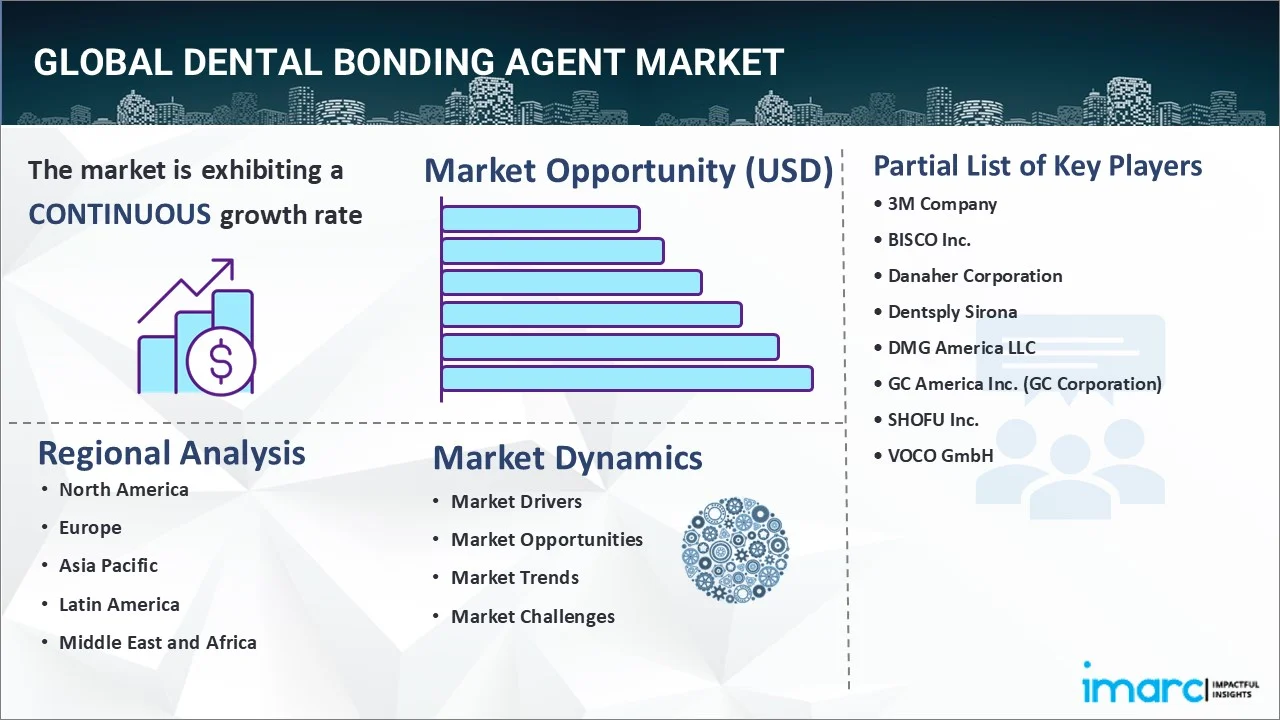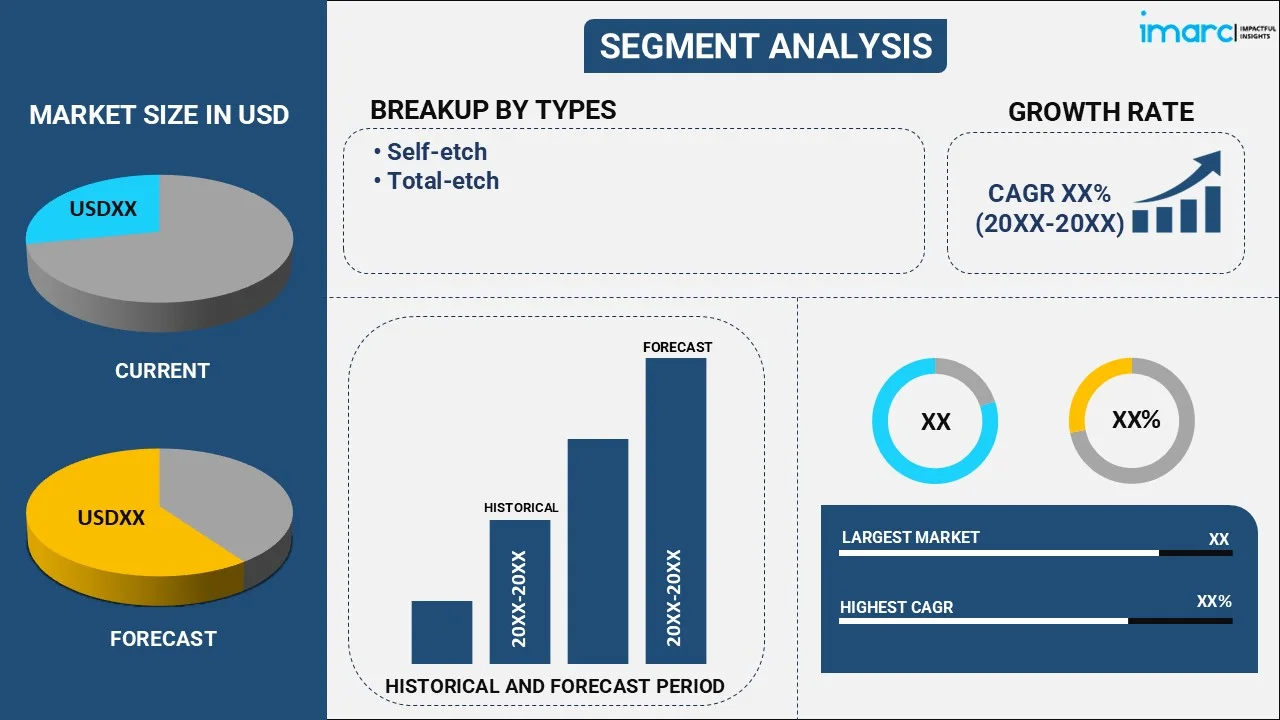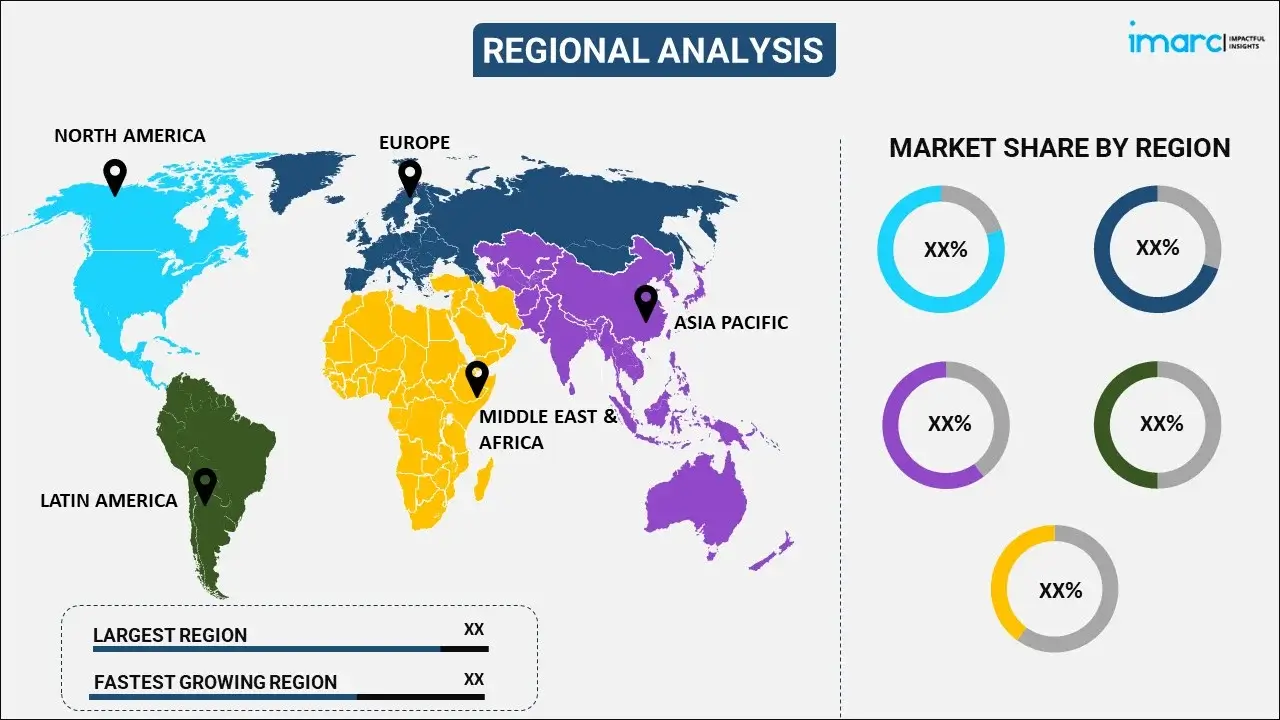
Dental Bonding Agent Market Report by Type (Self-Etch, Total-Etch), End User (Hospitals, Dental Clinics, Ambulatory Surgical Centers, and Others), and Region 2025-2033
Market Overview:
The global dental bonding agent market size reached USD 18.4 Billion in 2024. Looking forward, IMARC Group expects the market to reach USD 34.0 Billion by 2033, exhibiting a growth rate (CAGR) of 7.08% during 2025-2033. The increasing dental disorders and ailments, rapid technological advancements, rising geriatric population, increasing product utilization in cosmetic dentistry, rapid expansion of dental care facilities, and growing number of campaigns promoting dental hygiene are some of the major factors propelling the market.
|
Report Attribute
|
Key Statistics |
|---|---|
|
Base Year
|
2024 |
|
Forecast Years
|
2025-2033
|
|
Historical Years
|
2019-2024
|
| Market Size in 2024 | USD 18.4 Billion |
| Market Forecast in 2033 | USD 34.0 Billion |
| Market Growth Rate (2025-2033) | 7.08% |
Dental bonding agent refers to substances used to create a strong adherence between the tooth's structure and the filling or composite resin. It is manufactured using various materials, such as resins, solvents, and other bonding elements. Dental bonding agents are widely used in various dental procedures, such as filling cavities, repairing chipped teeth, closing gaps between teeth, fixing discoloration, adhering to bridges and crowns, treating root sensitivity, and supporting dental sealants. It offers improved bond strength, increased durability of dental work, enhanced aesthetic appearance, reduced risk of leakage, and compatibility with various dental materials.

The rising product utilization in cosmetic dentistry to improve patients' smiles and overall appearance is propelling the market growth. Additionally, the rapid expansion of dental care facilities, coupled with the increased awareness of dental health, is boosting the market growth. Besides this, the increasing number of campaigns promoting dental hygiene and education on advanced dental treatments is acting as another growth-inducing factor. Along with this, the implementation of supportive policies by governments and regulatory bodies encouraging the use of certified and effective dental bonding agents to ensure patient safety is positively influencing the market growth. Furthermore, the rising disposable income, which enables more individuals to afford complex dental procedures, is contributing to the market growth. Moreover, the growing demand for minimally invasive (MI) dental solutions among patients is strengthening the market growth.
Dental Bonding Agent Market Trends/Drivers:
The increasing dental disorders and ailments
The increasing incidences of dental disorders and ailments due to lifestyle changes, dietary habits, lack of proper dental hygiene, and genetics is propelling the market growth. Furthermore, the rising number of issues, such as cavities, gum diseases, tooth sensitivity, and enamel degradation, which necessitates the use of dental bonding agents in restorative and preventive treatments, is contributing to the market growth. Additionally, dental bonding agents play a crucial role in repairing and rebuilding teeth, making them an essential component of modern dental care. Moreover, the surge in public awareness regarding oral health, which has led to more people seeking professional dental treatment, is acting as another growth-inducing factor. Besides this, the increasing recognition of the correlation between general health and oral health among the masses is further fueling the demand for quality dental care.
The rapid technological advancements
The dental industry has been experiencing remarkable technological advancements, including in the area of dental bonding agents. In line with this, the development of new materials, application methods, and chemical formulations to enhance the effectiveness and efficiency of dental bonding is propelling the market growth. Furthermore, these innovations provide stronger adhesion, better aesthetics, and increased longevity of dental restorations. Along with this, the introduction of nanotechnology in bonding agents, which has paved the way for better penetration and bonding at a microscopic level, is positively influencing the market growth. Moreover, the ongoing research and development (R&D) in the field are also focusing on biocompatibility, ensuring that bonding agents are safe and well-tolerated. Additionally, the continuous investment in research, coupled with a drive for excellence, which has led to the emergence of products that are not only superior in quality but also tailored to specific dental needs, is supporting the market growth.
The rising geriatric population across the globe
The rising geriatric population, which is experiencing a range of dental problems, such as tooth loss, wear, decay, and gum diseases, that require specialized care and restorative treatments, is boosting the market growth. In line with this, dental bonding agents are integral to many of these dental treatments, such as filling cavities, affixing crowns, or cosmetic enhancements to ensure the durability of dental work and increase patient outcomes. Moreover, the modern geriatric population is more conscious of maintaining a healthy and appealing smile, which is further bolstering the market growth. Apart from this, the various governments and healthcare systems are also recognizing the importance of oral health in the geriatric population, leading to policies and programs that facilitate access to dental care.
Dental Bonding Agent Industry Segmentation:
IMARC Group provides an analysis of the key trends in each segment of the global dental bonding agent market report, along with forecasts at the global, regional, and country levels from 2025-2033. Our report has categorized the market based on type and end user.
Breakup by Type:

- Self-etch
- Total-etch
Self-etch holds the largest market share.
The report has provided a detailed breakup and analysis of the dental bonding agent market based on the type. This includes self-etch and total-etch. According to the report, self-etch represented the largest market segment.
Self-etch is dominating the market as it provides a simplified process, which reduces the chance of procedural errors, thus making it more appealing to the dental professional. Furthermore, it saves time during the dental procedure, as it eliminates the need for a separate etching step. This efficiency is favorable in busy dental practices and enhances patient comfort by reducing time spent in the dental chair. Besides this, self-etch bonding agents produce less postoperative sensitivity in patients, as they create a less permeable hybrid layer, resulting in less discomfort for the patient. Moreover, they are compatible with various dental restoration materials and procedures, which makes them suitable for different clinical situations, thus increasing their popularity among dental practitioners.
Breakup by End User:
- Hospitals
- Dental Clinics
- Ambulatory Surgical Centers
- Others
Dental Clinics holds the largest market share.
The report has provided a detailed breakup and analysis of the dental bonding agent market based on end user. This includes hospitals, dental clinics, ambulatory surgical centers, and others. According to the report, dental clinics represented the largest market segment.
Dental clinics are dominating the market as they are more accessible and widespread compared to larger dental hospitals. They are found in urban centers, suburbs, and even rural areas, making dental care, including procedures requiring bonding agents, available to a broad population. Furthermore, they focus on specialized treatments, such as cosmetic dentistry, restorative work, and preventive care, where dental bonding agents are frequently used. Besides this, dental clinics provide services at various price points, thus accommodating different economic backgrounds. Moreover, they are increasingly adopting modern technologies and methods, including the use of advanced dental bonding agents, particularly in cosmetic and restorative procedures. Besides this, dental clinics emphasize personalized and patient-centric care, where bonding procedures are commonly required for customized treatments.
Breakup by Region:

- North America
- United States
- Canada
- Europe
- Germany
- France
- United Kingdom
- Italy
- Spain
- Others
- Asia Pacific
- China
- Japan
- India
- South Korea
- Australia
- Indonesia
- Others
- Latin America
- Brazil
- Mexico
- Others
- Middle East and Africa
North America exhibits a clear dominance in the market, accounting for the largest dental bonding agent market share.
The report has also provided a comprehensive analysis of all the major regional markets, which includes North America (the United States and Canada); Europe (Germany, France, the United Kingdom, Italy, Spain, and others); Asia Pacific (China, Japan, India, South Korea, Australia, Indonesia, and others); Latin America (Brazil, Mexico, and others); and the Middle East and Africa. According to the report, North America accounted for the largest market share.
North America is at the forefront of dental technology and innovation, as it hosts leading research institutions and companies specializing in dental products, including dental bonding agents. Moreover, the escalating healthcare expenditure in the region, which ensures that dental clinics and hospitals are equipped with the latest tools and materials, including various types of dental bonding agents, is boosting the market growth. Besides this, the significant growth in cosmetic dentistry in North America, owing to the rising consumer expenditure capacities, is boosting the market growth. Furthermore, the escalating prevalence of lifestyle-related dental disorders, coupled with a focus on preventive dental care, is positively influencing the market growth. Apart from this, the introduction of comprehensive dental insurance and flexible dental plans, which makes dental treatments more accessible and affordable for a wide population, is supporting the market growth.
Competitive Landscape:
The leading dental bonding agent companies are focusing on research and development (R&D) to create cutting-edge products, improve existing ones, and explore new applications of dental bonding agents. Furthermore, they are forming alliances, mergers, or acquiring smaller companies and startups with unique technologies to expand product portfolios, reach new markets, and leverage synergies. Additionally, several key players are expanding into emerging markets and strengthening their presence in existing ones through local partnerships, distribution networks, and marketing campaigns. Moreover, they are adhering to stringent regulatory standards and certifications, which enhances product reliability and trust among dental professionals. Apart from this, the top companies are offering customized solutions to dental clinics and hospitals to cater to specific needs, patient demographics, and local market trends.
The report has provided a comprehensive analysis of the competitive landscape in the global dental bonding agent market. Detailed profiles of all major companies have also been provided. Some of the key players in the market include:
- 3M Company
- BISCO Inc.
- Danaher Corporation
- Dentsply Sirona
- DMG America LLC
- GC America Inc. (GC Corporation)
- SHOFU Inc.
- VOCO GmbH
Dental Bonding Agent Market Report Scope:
| Report Features | Details |
|---|---|
| Base Year of the Analysis | 2024 |
| Historical Period | 2019-2024 |
| Forecast Period | 2025-2033 |
| Units | Billion USD |
| Scope of the Report | Exploration of Historical and Forecast Trends, Industry Catalysts and Challenges, Segment-Wise Historical and Predictive Market Assessment:
|
| Types Covered | Self-Etch, Total-Etch |
| End Users Covered | Hospitals, Dental Clinics, Ambulatory Surgical Centers, Others |
| Regions Covered | Asia Pacific, Europe, North America, Latin America, Middle East and Africa |
| Countries Covered | United States, Canada, Germany, France, United Kingdom, Italy, Spain, China, Japan, India, South Korea, Australia, Indonesia, Brazil, Mexico |
| Companies Covered | 3M Company, BISCO Inc., Danaher Corporation, Dentsply Sirona, DMG America LLC, GC America Inc. (GC Corporation), SHOFU Inc., VOCO GmbH, etc. |
| Customization Scope | 10% Free Customization |
| Post-Sale Analyst Support | 10-12 Weeks |
| Delivery Format | PDF and Excel through Email (We can also provide the editable version of the report in PPT/Word format on special request) |
Key Benefits for Stakeholders:
- IMARC’s report offers a comprehensive quantitative analysis of various market segments, historical and current market trends, market forecasts, and dynamics of the dental bonding agent market from 2019-2033.
- The research study provides the latest information on the market drivers, challenges, and opportunities in the global dental bonding agent market.
- The study maps the leading, as well as the fastest-growing, regional markets. It further enables stakeholders to identify the key country-level markets within each region.
- Porter's five forces analysis assist stakeholders in assessing the impact of new entrants, competitive rivalry, supplier power, buyer power, and the threat of substitution. It helps stakeholders to analyze the level of competition within the dental bonding agent industry and its attractiveness.
- Competitive landscape allows stakeholders to understand their competitive environment and provides an insight into the current positions of key players in the market.
Key Questions Answered in This Report
The dental bonding agent market was valued at USD 18.4 Billion in 2024.
The dental bonding agent market is projected to exhibit a CAGR of 7.08% during 2025-2033.
The dental bonding agent market is driven by the growing demand for cosmetic dental procedures, including tooth restoration and whitening. Advancements in dental materials, increasing awareness about oral hygiene, and rising disposable incomes contribute to market growth. Additionally, the popularity of minimally invasive treatments and aesthetic dentistry boosts adoption.
North America currently dominates the market driven by the leading research institutions and companies specializing in dental products, including dental bonding agents along with the escalating healthcare expenditure in the region which ensures that dental clinics and hospitals are equipped with the latest tools and materials, including various types of dental bonding agents.
Some of the major players in the dental bonding agent market include 3M Company, BISCO Inc., Danaher Corporation, Dentsply Sirona, DMG America LLC, GC America Inc. (GC Corporation), SHOFU Inc., VOCO GmbH, etc.
Need more help?
- Speak to our experienced analysts for insights on the current market scenarios.
- Include additional segments and countries to customize the report as per your requirement.
- Gain an unparalleled competitive advantage in your domain by understanding how to utilize the report and positively impacting your operations and revenue.
- For further assistance, please connect with our analysts.
 Request Customization
Request Customization
 Speak to an Analyst
Speak to an Analyst
 Request Brochure
Request Brochure
 Inquire Before Buying
Inquire Before Buying




.webp)




.webp)












